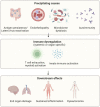Long COVID: Clinical characteristics, proposed pathogenesis and potential therapeutic targets
- PMID: 37179568
- PMCID: PMC10171433
- DOI: 10.3389/fmolb.2023.1157651
Long COVID: Clinical characteristics, proposed pathogenesis and potential therapeutic targets
Abstract
The emergence of persistent ill-health in the aftermath of SARS-CoV-2 infection has presented significant challenges to patients, healthcare workers and researchers. Termed long COVID, or post-acute sequelae of COVID-19 (PASC), the symptoms of this condition are highly variable and span multiple body systems. The underlying pathophysiology remains poorly understood, with no therapeutic agents proven to be effective. This narrative review describes predominant clinical features and phenotypes of long COVID alongside the data supporting potential pathogenesis of these phenotypes including ongoing immune dysregulation, viral persistence, endotheliopathy, gastrointestinal microbiome disturbance, autoimmunity, and dysautonomia. Finally, we describe current potential therapies under investigation, as well as future potential therapeutic options based on the proposed pathogenesis research.
Keywords: PASC; SARS-CoV-2; long COVID; post COVID condition; post-acute sequelae of SARS-CoV-2 infection.
Copyright © 2023 Kenny, Townsend, Savinelli and Mallon.
Conflict of interest statement
The authors declare that the research was conducted in the absence of any commercial or financial relationships that could be construed as a potential conflict of interest.
Figures



References
-
- Alba G. A., Ziehr D. R., Rouvina J. N., Hariri L. P., Knipe R. S., Medoff B. D., et al. (2021). Exercise performance in patients with post-acute sequelae of SARS-CoV-2 infection compared to patients with unexplained dyspnea. EClinicalMedicine 39, 101066. 10.1016/j.eclinm.2021.101066 - DOI - PMC - PubMed
-
- Antonelli M., Penfold R. S., Merino J., Sudre C. H., Molteni E., Berry S., et al. (2022). Risk factors and disease profile of post-vaccination SARS-CoV-2 infection in UK users of the COVID symptom study app: A prospective, community-based, nested, case-control study. Lancet Infect. Dis. 22 (1), 43–55. 10.1016/S1473-3099(21)00460-6 - DOI - PMC - PubMed
Publication types
LinkOut - more resources
Full Text Sources
Miscellaneous

